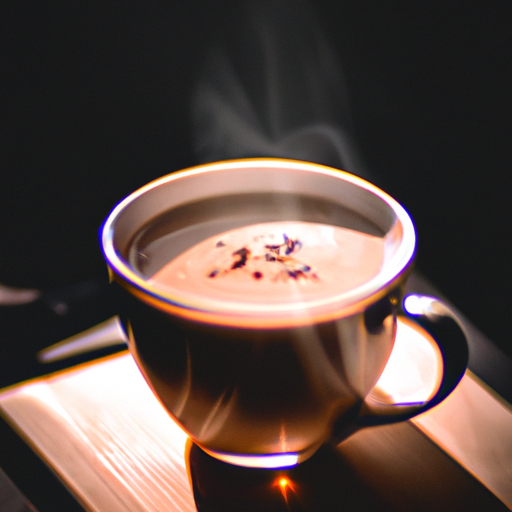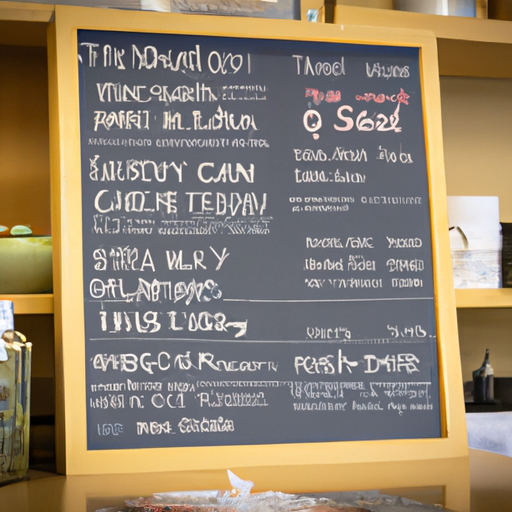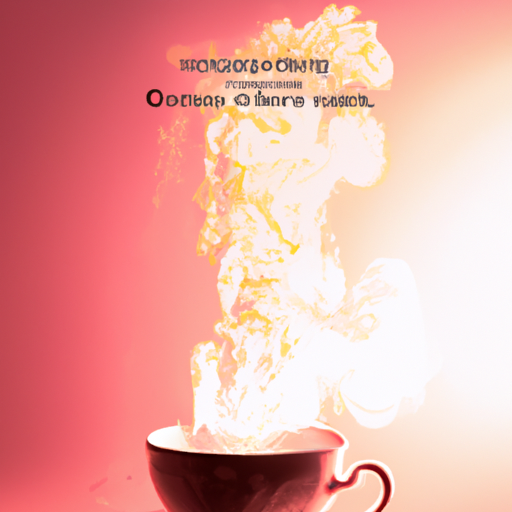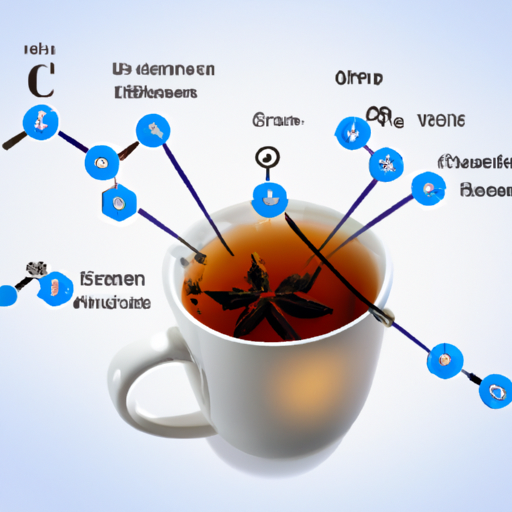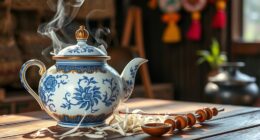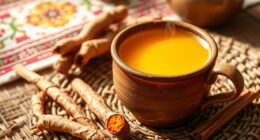As someone who has a passion for tea, I am constantly in search of distinctive and tasty mixtures that meet my desires. In recent times, Dirty Chai Tea has piqued my interest as one such blend.
But what exactly is it? Dirty Chai Tea is a delicious and popular beverage that combines traditional chai tea with espresso or coffee. The result is a rich and creamy drink with a kick of caffeine.
The origins of Dirty Chai Tea can be traced back to India, where traditional Masala chai tea has been enjoyed for centuries. The addition of espresso or coffee to this classic drink was first introduced in Western countries as a way to enhance its flavor and give it an extra boost of energy.
Today, Dirty Chai Tea can be found on the menus of many cafes and coffee shops around the world, and it continues to gain popularity among tea lovers who are looking for something new and exciting.
Key Takeaways
- Dirty Chai Tea is a blend of traditional chai tea with espresso or coffee, offering a rich and creamy drink with a kick of caffeine.
- Dirty Chai Tea is made up of black tea, steamed milk, espresso shots, and a variety of spices, with popular milk options including dairy milk, almond milk, soy milk, or coconut milk.
- Dirty Chai Tea offers several nutritional values, including anti-inflammatory properties from the spices, caffeine to boost metabolism and enhance mental alertness, and essential vitamins and minerals from the added milk.
- Dirty Chai Tea can be found at local coffee shops, tea houses, and specialty tea shops, with etiquette rules for ordering including specifying the addition of an espresso shot and asking for extra foam or whipped cream on top if desired.
What is Dirty Chai Tea?
You’ve probably heard of chai tea, but have you tried the deliciously spiced and energizing drink known as dirty chai? This popular beverage is a combination of black tea, steamed milk, espresso shots, and a variety of spices. Some common ingredients for dirty chai include cinnamon, cardamom, ginger, clove, and nutmeg. The result is a fragrant and flavorful drink that packs a powerful punch.
While the origins of dirty chai are not clear, it has become increasingly popular in recent years. It is especially popular in countries like India and Nepal where traditional masala chai is already widely consumed. However, it has also gained popularity in places like Australia and the United States where coffee culture reigns supreme. Its unique blend of coffee and tea makes it an appealing choice for those who want to enjoy the benefits of both beverages.
Now that we know what dirty chai is made up of and how it’s enjoyed around the world, let’s dive into its history. Chai tea has been around for centuries and has its roots in South Asia. As we explore the history of this beloved beverage, we’ll uncover interesting facts about how it evolved over time to become what we know today as ‘chai’.
The History of Chai Tea
The origins of this beloved beverage can be traced back centuries, to the Indian subcontinent where it was first consumed for its medicinal properties. Chai tea, also known as masala chai, is a blend of black tea and spices such as cinnamon, cardamom, ginger, and cloves. It has been an integral part of Indian culture for generations and continues to be enjoyed worldwide.
To give you a sense of what it’s like to drink chai tea in India, imagine sitting in a bustling street market surrounded by vibrant colors and sounds. Inhaling the sweet aroma of freshly brewed chai being served from a roadside stall. Watching as the vendor expertly pours the hot liquid from one cup to another in order to create froth.
Chai tea has cultural significance beyond just its taste and aroma. It’s often used as a symbol of hospitality and friendship in Indian households. The act of offering someone chai is seen as an expression of warmth and kindness.
Understanding the cultural significance behind chai tea adds depth to our appreciation of this delicious beverage. Now that we know about its origins and importance in Indian culture, let’s explore how we can make our own twist on this classic drink with dirty chai tea.
How to Make Dirty Chai Tea
Imagine walking into a cozy coffee shop on a crisp autumn morning and ordering a warm, spiced latte with a shot of espresso to add an extra kick of caffeine. This delightful drink is called Dirty Chai Tea, which combines the traditional Indian tea known as chai with a shot of espresso.
Making this beverage requires some knowledge about spice options and milk choices. Spice options are one of the key components that give dirty chai its unique taste. Some popular spices include ginger, cinnamon, cardamom, cloves, and nutmeg. These spices are typically mixed into black tea to create the base for the drink. The amount of spice used can vary depending on personal preference or recipe instructions.
Milk choices also play an important role in making dirty chai tea. Common milk options include dairy milk, almond milk, soy milk, or coconut milk. The type of milk used can affect the overall taste and texture of the drink. It’s essential to choose one that complements your preferred spice mix and enhances the flavors without overpowering them.
With these steps mastered, you’re ready to explore different variations of dirty chai tea- from cold brew versions to frozen beverages!
Different Variations of Dirty Chai Tea
Get ready to spice up your morning routine with a variety of invigorating and flavorful twists on this beloved coffee shop classic. Dirty chai tea is a delicious blend of black tea, espresso, milk, and spices like cinnamon and cardamom. But did you know that you can take this already delicious drink to the next level by experimenting with different flavors and brewing methods?
One way to switch up the flavor profile of your dirty chai tea is by adding different types of syrups or extracts. Vanilla syrup or almond extract can add a sweet twist, while caramel syrup or hazelnut extract can give it a nutty flavor. You could also try adding some honey for a natural sweetness.
Another way to vary the taste of your dirty chai tea is by changing up your brewing method. For example, instead of using traditional black tea leaves, you could use green or herbal teas for a lighter taste. Alternatively, try cold-brewing your tea overnight for a refreshing iced version.
By exploring these different flavors and brewing methods, you can create a unique version of dirty chai tea that suits your individual tastes. And if you’re looking for even more reasons to love this beverage, stay tuned for our discussion about the health benefits of dirty chai tea.
As we’ve seen, there are many ways to experiment with flavors and brewing techniques when making dirty chai tea. However you choose to make it, this spicy-sweet beverage is sure to wake up your senses and get you ready for the day ahead. So why not give it a try?
In the next section, we’ll explore some of the potential health benefits that come along with drinking this tasty treat on a regular basis.
Health Benefits of Dirty Chai Tea
Rev up your wellness routine with the potential health benefits of this spiced espresso-infused beverage. Dirty chai tea is a flavorful and aromatic drink that offers several nutritional values.
The spices present in this exotic tea, such as cinnamon, ginger, cardamom, and cloves, are known for their anti-inflammatory properties that can help reduce inflammation in the body. Moreover, dirty chai tea also contains caffeine that can boost metabolism and enhance mental alertness.
The addition of milk to the beverage provides essential vitamins and minerals like calcium, vitamin D, and potassium. However, it’s crucial to be mindful of the sugar content when adding sweeteners like honey or sugar to your brew. Brewing methods also play a significant role in maximizing the health benefits of dirty chai tea.
Brew it at home using high-quality ingredients like organic black tea leaves, freshly grounded spices, and non-dairy milk alternatives for those who are lactose intolerant or vegan. Enjoy this delightful concoction anytime throughout the day as an alternative to plain coffee or tea to reap its numerous health benefits.
Transition into the subsequent section about the best time to drink dirty chai tea: Whether you prefer drinking it in the morning as a pick-me-up or during afternoon breaks as a midday treat – one thing’s for sure – there’s never really a bad time to enjoy a steaming cup of dirty chai tea!
Best Time to Drink Dirty Chai Tea
Indulging in a warm and spicy cup of Dirty Chai Tea can be the perfect way to start your day or unwind after a long one. If you’re wondering when the best time is to drink this delicious beverage, here are some suggestions.
Firstly, consider drinking Dirty Chai Tea in the morning as it contains caffeine, which can help boost your energy levels and improve mental alertness. To get the best brewing results, steep black tea bags for five minutes before adding milk, spices, and sweetener. You can even add extra ginger or cinnamon for an added kick.
If you prefer to drink tea later in the day but still want something with caffeine, then Dirty Chai Tea could be an excellent option. It’s also a great choice after dinner as it helps aid digestion thanks to its natural digestive properties.
For pairing suggestions, try it with buttery croissants or toast for breakfast or chocolate cake for dessert.
Whether you’re looking for an early morning pick-me-up or something to sip on after dinner, Dirty Chai Tea is a versatile beverage that can suit any occasion.
Next up, let’s discuss where you can find this delicious brew!
Where to Find Dirty Chai Tea
Satisfy your cravings for a warm and spicy beverage by discovering the perfect places to order this popular fusion drink. Dirty chai tea is becoming more and more popular, so finding it at your local coffee shop or tea house shouldn’t be too difficult.
In fact, many chain coffee shops like Starbucks and Dunkin’ Donuts offer their own version of dirty chai tea. However, if you want to try out different variations of this beverage, there are also specialty tea shops that serve dirty chai tea made with unique blends of spices and teas.
These stores often offer DIY recipes and sell the necessary ingredients for you to make your own at home. It’s a great option for those who want to experiment with different flavors and spice levels. If you’re looking for a convenient way to try out this delicious drink, head over to your nearest coffee shop or visit a specialty tea store.
But before you do that, check out some tips on how to order the perfect cup of dirty chai tea in the next section!
Tips for Ordering Dirty Chai Tea
Unlock the full potential of your taste buds by ordering a dirty chai tea, a delicious blend of black tea, steamed milk, and aromatic spices such as cinnamon, cardamom, and ginger. This popular drink is perfect for those who want to enjoy both the flavors of chai tea and espresso in one cup.
When it comes to ordering dirty chai tea at your local coffee shop or café, there are some etiquette rules you should follow. First and foremost, make sure to specify that you want an espresso shot added to your chai latte. You can also ask for extra foam or whipped cream on top if you prefer a creamier consistency.
Some popular brands that serve dirty chai tea include Starbucks, Peet’s Coffee & Tea, and Caribou Coffee.
If you’re looking for an alternative to dirty chai tea, there are other options available at most coffee shops. For example, you can try a regular chai latte without the added espresso shot or opt for a hot chocolate with spices such as cinnamon or nutmeg added in.
Whatever your preference may be, don’t be afraid to experiment with different drinks until you find one that suits your taste buds perfectly.
Alternatives to Dirty Chai Tea
As a fan of chai tea, I often find myself looking for alternatives to the popular Dirty Chai Tea.
Two great options that come to mind are the Chai Tea Latte and Espresso.
A Chai Tea Latte is made with steamed milk and chai tea concentrate, while an Espresso is a concentrated shot of coffee.
Both provide a delicious kick of caffeine without the added spices found in a Dirty Chai Tea.
Chai Tea Latte
If you’re looking for a cozy, spiced drink with a kick of caffeine, you can’t go wrong with a chai tea latte. Chai tea lattes are made by combining chai tea concentrate or loose-leaf tea with steamed milk and sweetener.
The result is a creamy, aromatic beverage that’s perfect for sipping on chilly days. One of the best things about chai tea lattes is their versatility.
There are many different chai tea flavors and recipes to choose from, so you can customize your drink to suit your taste preferences. Whether you prefer your chai spicy and bold or sweet and mellow, there’s sure to be a recipe out there that will tickle your taste buds.
And for those who need an extra boost in the morning, adding a shot of espresso to your latte (also known as a dirty chai) is always an option!
Espresso
You can’t beat the rich, bold flavor of an espresso shot. It packs a punch that’ll wake you up faster than a bolt of lightning. But sometimes, you may want to switch things up and try something different from your usual espresso shot.
Here are some popular espresso alternatives that you can find in many coffee shops:
-
Americano – This drink is made by adding hot water to a shot of espresso. It has a similar strength as drip coffee but with the intense flavor of espresso.
-
Cappuccino – A classic Italian drink made with equal parts espresso, steamed milk, and foam on top.
-
Macchiato – Espresso shots marked with just a dollop of steamed milk and foam on top.
-
Mocha – An indulgent treat made by adding chocolate syrup or cocoa powder to an espresso shot before topping it off with steamed milk.
If you’re looking for something even more unique, there are plenty of creative espresso-based drinks out there too! From affogatos to flat whites, the possibilities are endless.
As we wrap up our discussion on espressos and their alternatives, let’s transition into final thoughts on dirty chai tea.
Final Thoughts on Dirty Chai Tea
Overall, my impression of dirty chai tea is that it’s a complex and delicious beverage that offers the best of both coffee and chai tea worlds. As someone who loves both drinks, I appreciate the unique blend of flavors and aromas that come together in a single cup. However, as with any drink, there are pros and cons to consider.
In terms of pros, dirty chai tea is an excellent choice for those who want something different than a traditional latte or cappuccino. The addition of spices like cinnamon, cardamom, ginger, and clove give the drink a warm and comforting feel that’s perfect for cold days. Additionally, since it contains espresso alongside black tea, it has more caffeine than regular chai tea which can give you an extra boost when you need it.
On the other hand, there are some cons to be aware of before ordering a dirty chai tea. For one thing, not all coffee shops make them equally well – some may use too much milk or espresso which can overpower the delicate flavor of the spices. Also, since it contains both coffee and tea components, some people might find it too strong or bitter for their taste buds.
Ultimately though, my personal experience has been very positive with this drink and I’d recommend giving it a try if you’re looking for something new!
Frequently Asked Questions
What is the origin of the name ‘dirty chai tea’?
When it comes to the origin and etymology of the name ‘dirty chai tea,’ there isn’t a clear answer. However, based on cultural significance and regional variations, we can make some educated guesses.
It’s believed that dirty chai originated in India, where chai is a popular type of spiced tea. The addition of espresso or coffee to the mix likely came from the Western world’s love for caffeine and may have been popularized by coffee shops in America.
As for the name ‘dirty,’ it could refer to the mixing of two separate drinks, or it could be a nod to the earthy taste of Indian spices mixed with coffee.
Regardless of its precise origins, dirty chai has become a beloved drink for many around the world and has even spawned variations like iced dirty chai lattes or vegan dirty chais made with almond milk.
Can dirty chai tea be made with any type of tea?
Tea is a versatile beverage that can be enjoyed in many different ways. It’s fascinating how different tea blends can create unique flavors and aromas.
When it comes to dirty chai tea, the answer to whether it can be made with any type of tea is both yes and no. Dirty chai typically consists of black tea and espresso, but some variations use green or white tea as a base instead. However, the caffeine content will vary depending on the type of tea used.
It’s important to note that dirty chai is not a standardized recipe, so each café may have its own version with varying ingredients and proportions. Nevertheless, regardless of the type of tea used, adding espresso to it creates a bold and flavorful cup that is sure to wake you up in the morning!
What is the difference between a regular chai latte and a dirty chai latte?
When comparing a regular chai latte to a dirty chai latte, the main difference lies in the addition of espresso. A dirty chai latte is made by adding a shot or two of espresso to a traditional chai tea latte. This not only adds an extra kick of caffeine but also combines the robust flavors of both coffee and tea.
The spice level in both versions can vary depending on personal preference, but the addition of espresso often gives the drink a stronger and bolder taste compared to a regular chai latte. It’s important to note that the strength of the espresso used can also affect the overall flavor profile, so it’s worth experimenting with different types and amounts until you find your preferred balance.
Is it possible to make a vegan version of dirty chai tea?
When it comes to veganizing a dirty chai tea, the possibilities are endless. With the vast array of vegan milk alternatives on the market today, it’s easy to find one that suits your taste preferences and dietary needs.
From almond milk to soy milk and everything in between, each option brings its unique flavor profile to the table. Experimenting with different milk alternatives can lead to exciting flavor variations that can make your dirty chai tea stand out from the rest.
Whether you prefer a nutty undertone or a creamy finish, there is undoubtedly an option for you. So go ahead and try out different vegan milk alternatives in your next cup of dirty chai tea; who knows what delicious concoction you might come up with!
How many calories are in a typical serving of dirty chai tea?
The calorie count of a typical serving of dirty chai tea can vary depending on the ingredients used and the size of the drink. However, on average, a 12 oz cup of dirty chai tea with whole milk and sweetener contains around 240 calories.
This is due to the combination of black tea, spices such as cinnamon and cardamom, espresso shots, milk, and added sugar or syrup. It also has some nutritional value as it provides small amounts of calcium and iron from the milk and black tea.
Nevertheless, it’s important to be mindful of your overall caloric intake if you’re watching your weight or monitoring your blood sugar levels. If you prefer a lighter version with fewer calories, consider using skimmed milk or dairy-free alternatives like almond milk instead.
Conclusion
In conclusion, Dirty Chai Tea is a delicious and invigorating beverage that combines the bold flavors of coffee and tea with the spicy sweetness of chai. Whether you’re looking for a morning pick-me-up or an afternoon treat, this drink is sure to satisfy your cravings.
With its unique blend of caffeine and spices, Dirty Chai Tea offers numerous health benefits, including improved digestion and increased energy levels. If you’re interested in trying this popular beverage for yourself, there are many different ways to enjoy it. From traditional recipes to creative variations like iced or blended drinks, there’s something for everyone when it comes to Dirty Chai Tea.
Just be sure to order it correctly and always use high-quality ingredients for the best flavor experience. So if you’re looking for a flavorful and satisfying way to start your day or take a break from work, give Dirty Chai Tea a try today! Your taste buds will thank you for the rich mix of flavors in every sip.

